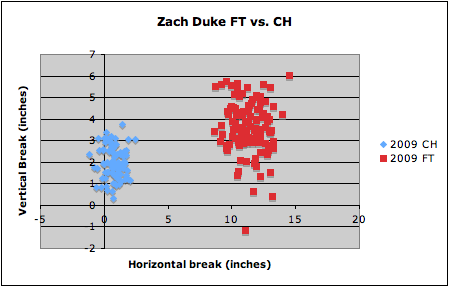Since the Ross Ohlendorf PitchFX stuff went over so well last week, I thought that the next obvious target for an in-depth PitchFX examination would be Zach Duke. He’s drastically improved over last year, to the point that he was actually named to the NL All-Star team on Sunday and he really kind of deserved it (if you view this year in a vacuum, at least). We know the Pirates’ defense has improved by leaps and bounds behind him as his BABIP has dropped from .327 last year to .271 this year. But what else is he doing differently?
To answer the question, I’ve pulled in all of the PitchFX data for games that Duke pitched at PNC Park in the past two seasons. There are some questions about park effect on PitchFX (I don’t think they effected my Ohlendorf study that much, but that’s a longer story), so this is the best way to neutralize that. And since Duke threw 1433 pitches at PNC last year and 874 there this year, I think we should still have plenty of data to look at.
For starters, Duke was made 15 starts at PNC last year. He went 4-8 with a 4.89 ERA, 4.7 K/9 (48 Ks in 92 innings), and his K/BB was 1.85. This year, he’s made nine starts at PNC, and he’s 6-3 with a 2.77 ERA and a 1.08 WHIP. Interestingly, his strikeouts at home are down to 4.3/9, but his K/BB has improved to 2.58. Clearly, he’s doing something better this year. Again, we’ll go after the jump to try and find out what it is.
Earlier this year, my hypothesis on Duke’s resurgence was that his fastball had more zip. This question isn’t as straightforward to answer as I thought it would be, though. In 2008, all 883 of Duke’s fastballs were labeled “FA”, which is a generic fastball. This year, they’re divided up into FA (88), FF (four-seamer, 383), and FT (two-seamer, 115). The average speed of the one fastball in 2008 was 88.7 mph. The average speed of all three fastballs combined in 2009 is 87.2 mph. If we break his fastballs up into two-seamers and four-seamers (assuming that the ones that get called FA are one or the other and they can’t be distinguished for some reason), his average four-seamer is 88.4 mph, while the two-seamer is only 81.3.
So right off the bat, we’ve got an interesting anomaly here. Did he throw a two-seamer at all in 2008? Let’s check the break on the pitches. Again, I’ll leave the pitches classified as “FA” in 2009 out, to keep the graph cleaner. The graph is plot horizontal break against vertical break. I’ll post the guide from Sons of Sam Horn again, but remember that because Duke is left-handed, the whole chart would appear as a mirror image for him.


So Duke’s two-seamer features some pretty good sink, it appears, but that doesn’t really seem like a unique feature, because there are plenty of blue dots that show the same sort of break from last year. Let’s compare vertical break and initial velocity for all three fastballs.

This graph makes it pretty clear that Duke’s throwing a two-seamer this year that actually behaves a bit more like a splitter; there’s a significant velocity loss to go with increased sink on the ball. It’s also behaves a bit differently than the changeup that he’s thrown 92 times this year. That pitch clocks in at a similar 81.8 mph, but it features much more break away from left-handed hitters than his fastballs do.

He’s essentially added another pitch. It’s not a two-seamer, but it is kind of another changeup that breaks a little differently to give hitters another look.
Next up is Duke’s breaking pitch, which is generally classified as a curve. Most anecdotal accounts say that his curve is much “sharper” this year. Is that really true?

A little surprisingly, I don’t see much of a difference between his curveballs from last year to this year. If anything, I feel like the curve is breaking a little bit less away from left-handed hitters. Perhaps this is intentional, as he has thrown more curves for strikes this year (jumping from a curveball strike rate of around 55% in 2008 to about 60% this year).
I really found all this kind of surprising. In terms of the pitches he throws most often — the fastball, curveball, and change — the only real variation in his stuff this year is a pitch that’s being called a two-seam fastball but is more likely a variation on his changeup. He does have better command this year and it’s not limited to his curveball; in 2008 he threw 62.4% of his pitches for strikes, in 2009 he’s hitting the strike zone 66.7% of the time. As a result, he’s throwing his curveball and changeup(s?) a little more and his fastball a little less, which I think we can safely assume is keeping hitters off balance a little better.
When we boil it all down, Duke hasn’t seen an increase in velocity and he hasn’t added significant break to his fastball or curveball. His command is improved and he’s changing speeds up better, which is perhaps because of a tweak he’s made to his changeup that gives it a different look. He’s improved, but certainly not as drastically as his traditional stats indicate. His FIP (basically an estimate of how his ERA would look without relying on fielders) is down this year, but by less than half a run (4.46 last year to 4.18 this year). Duke’s improved himself this year, but not nearly as much as the eight guys in the field have improved him.




















